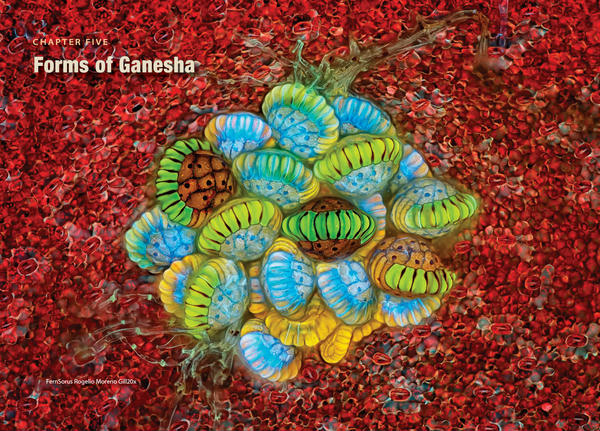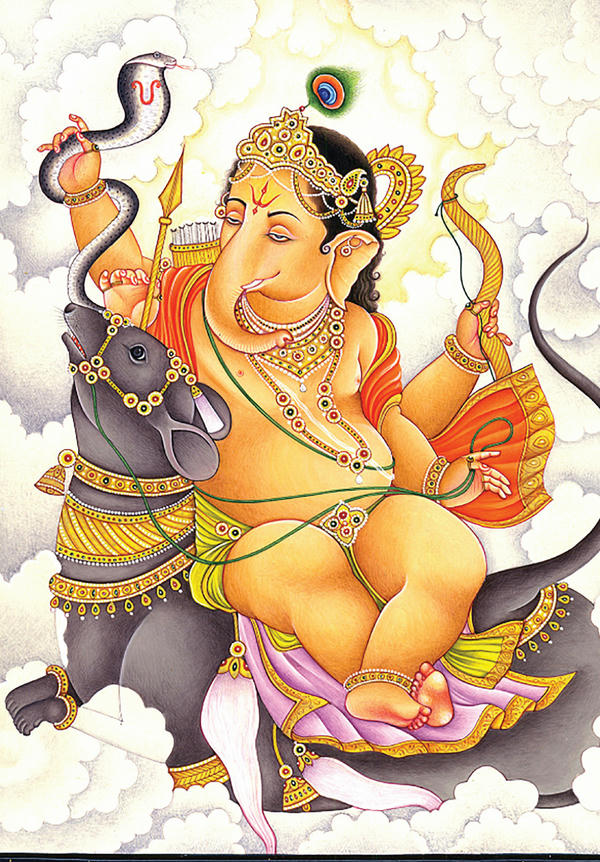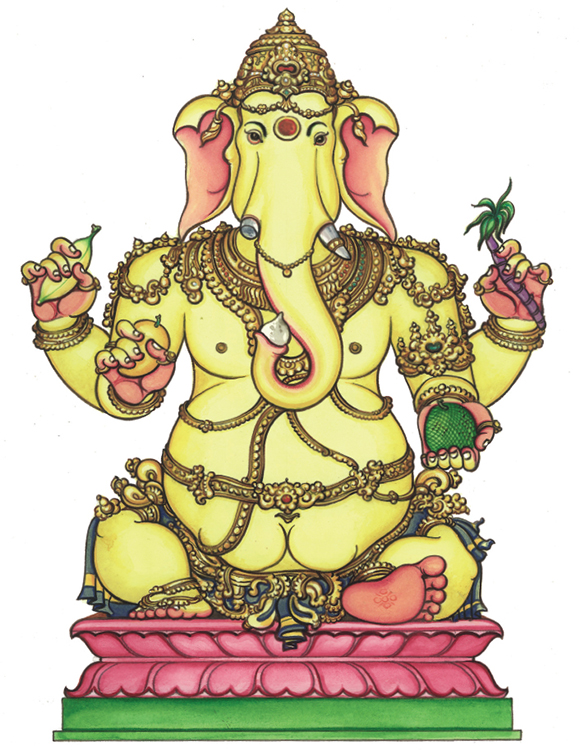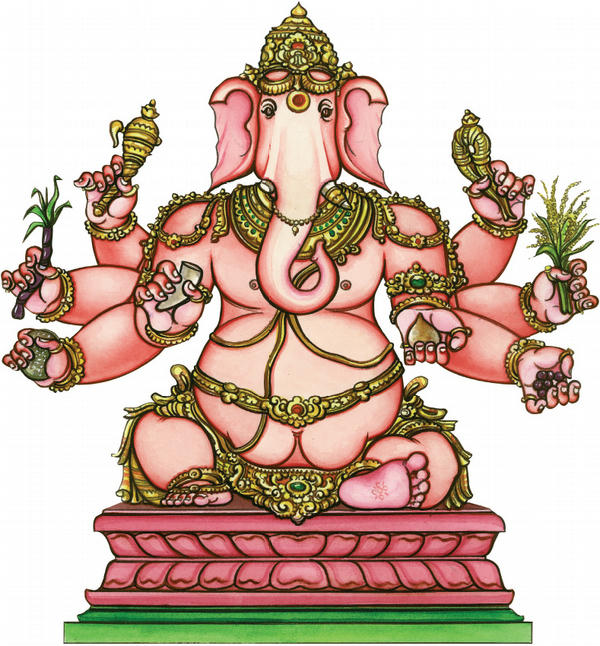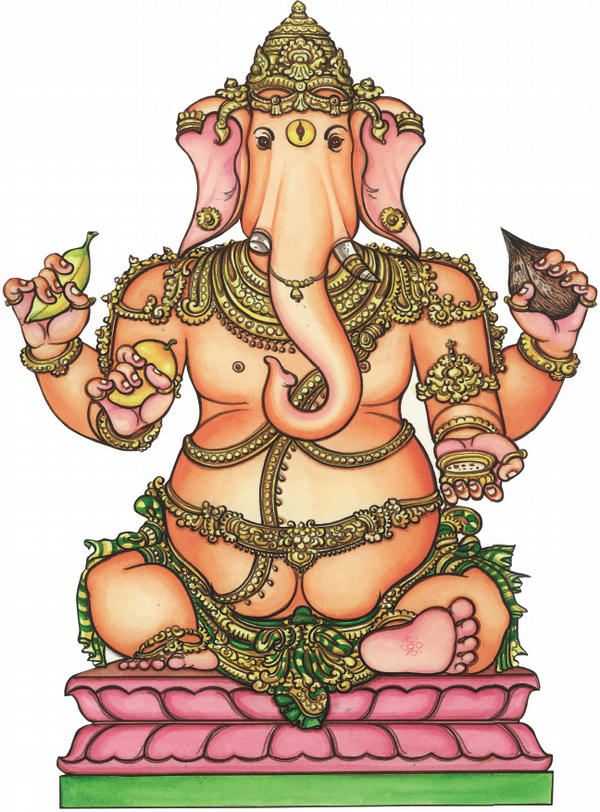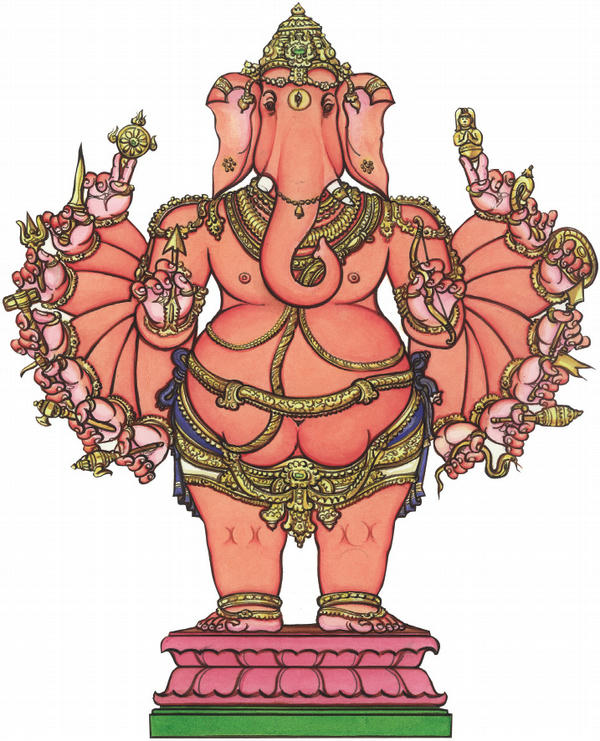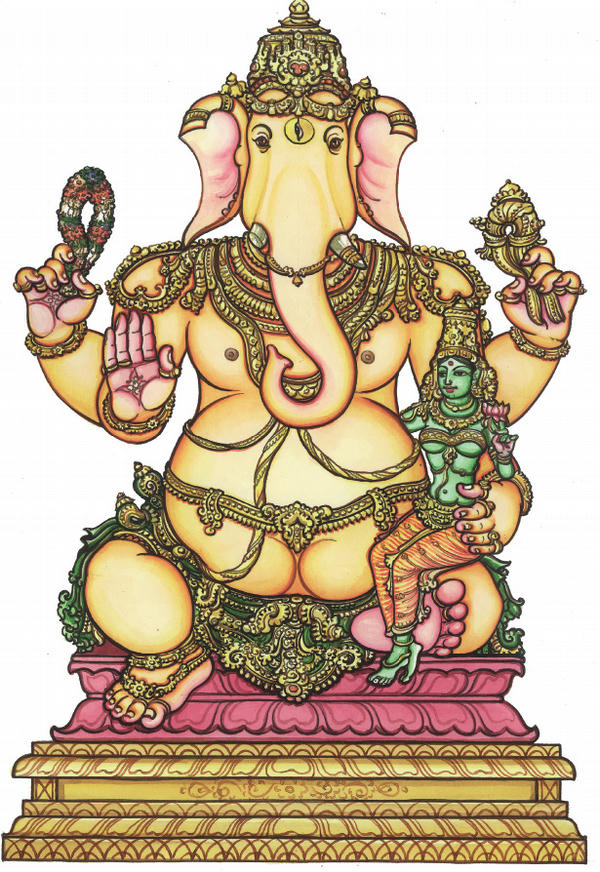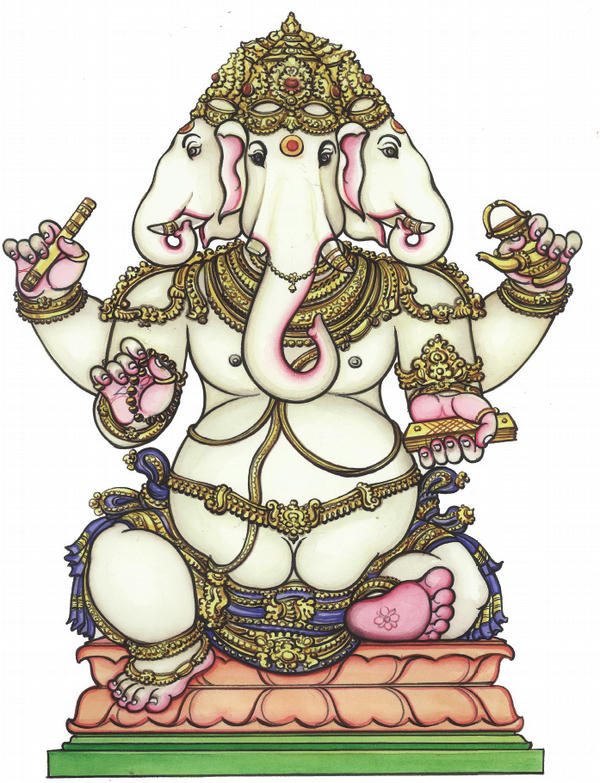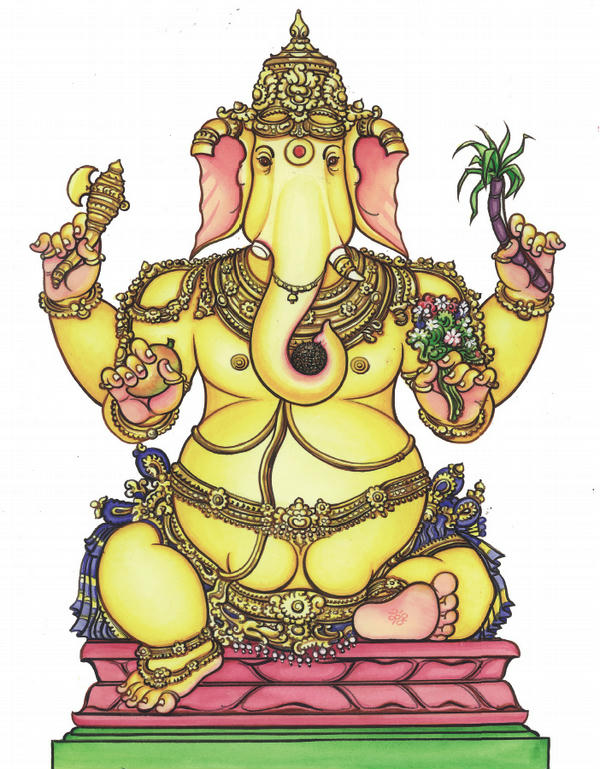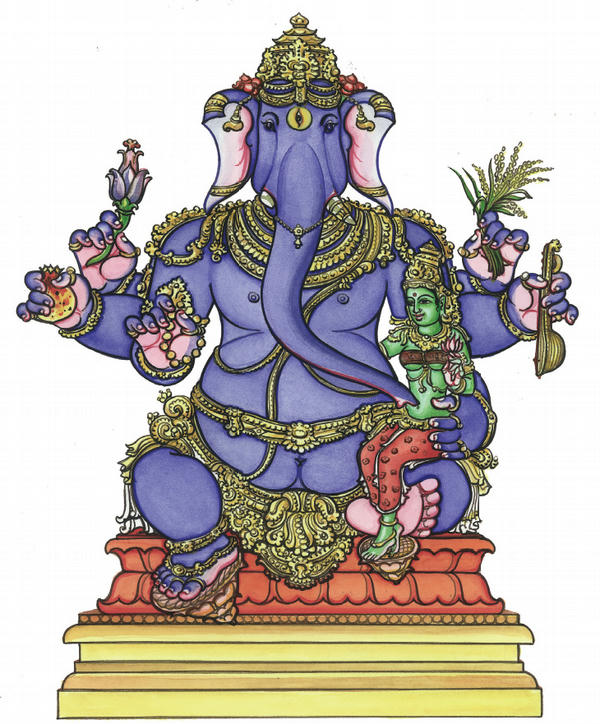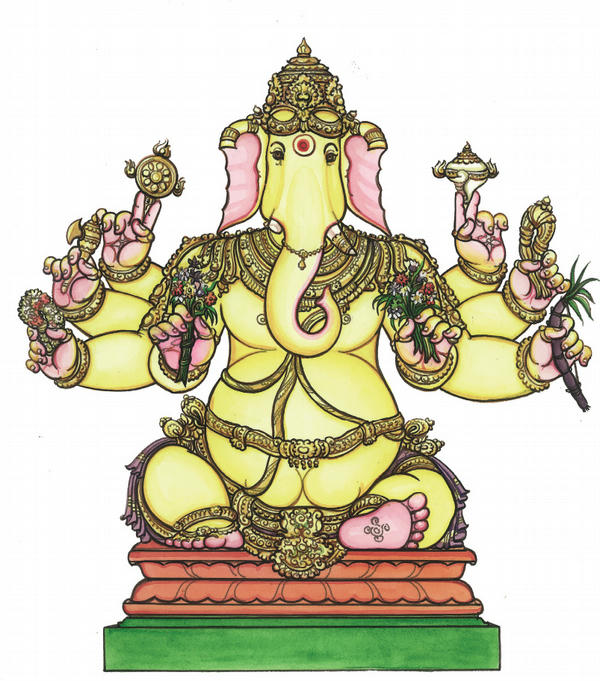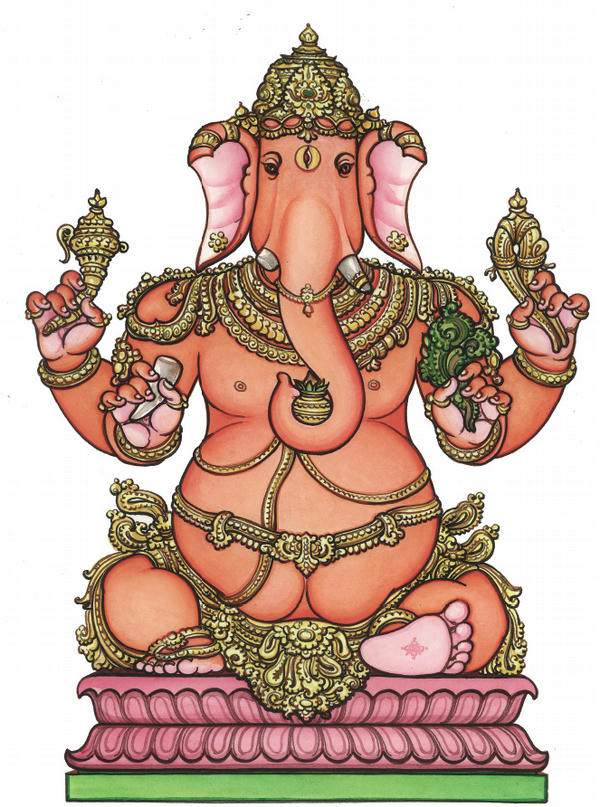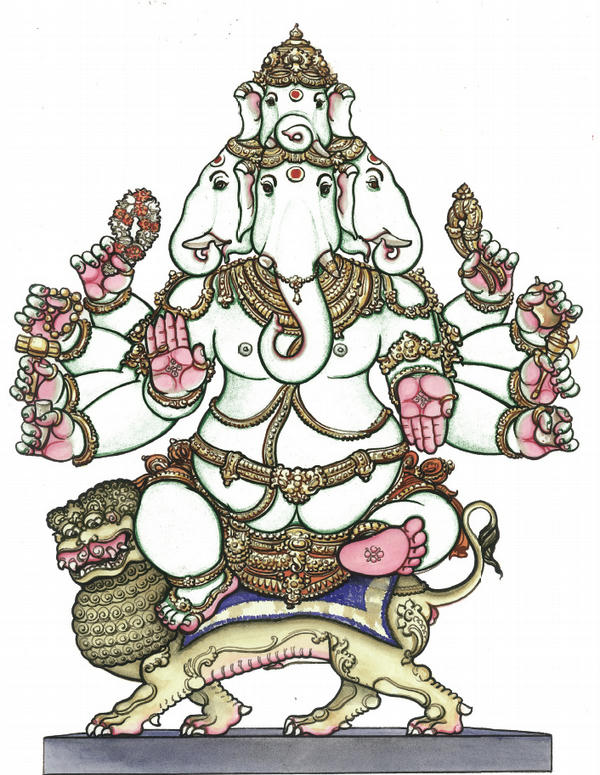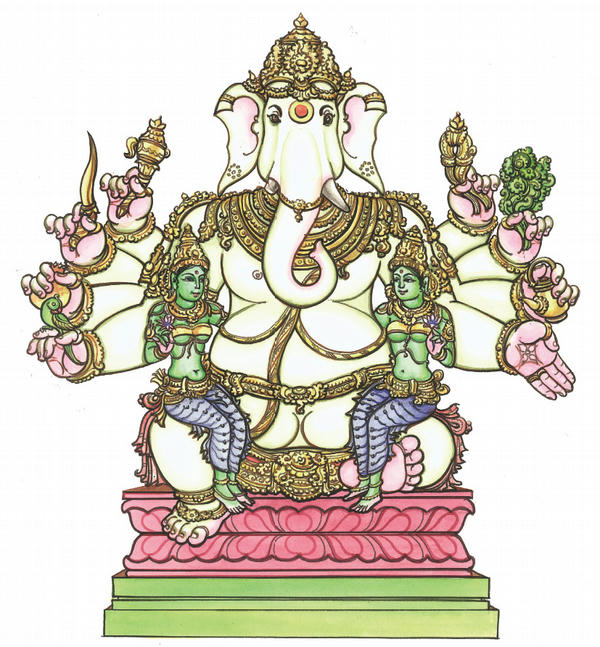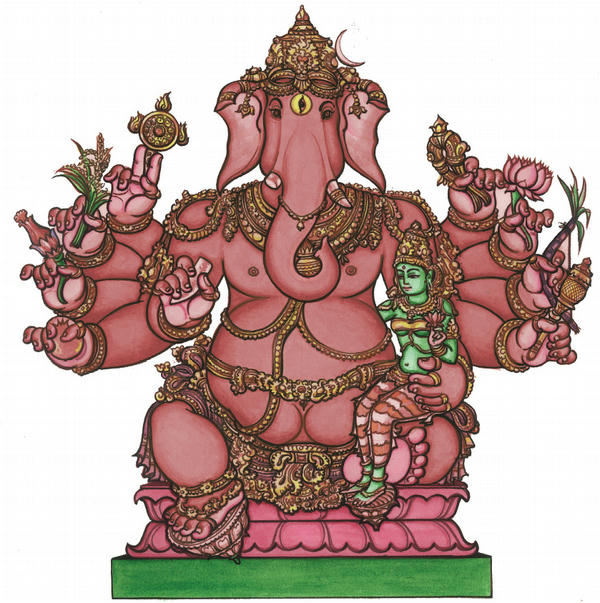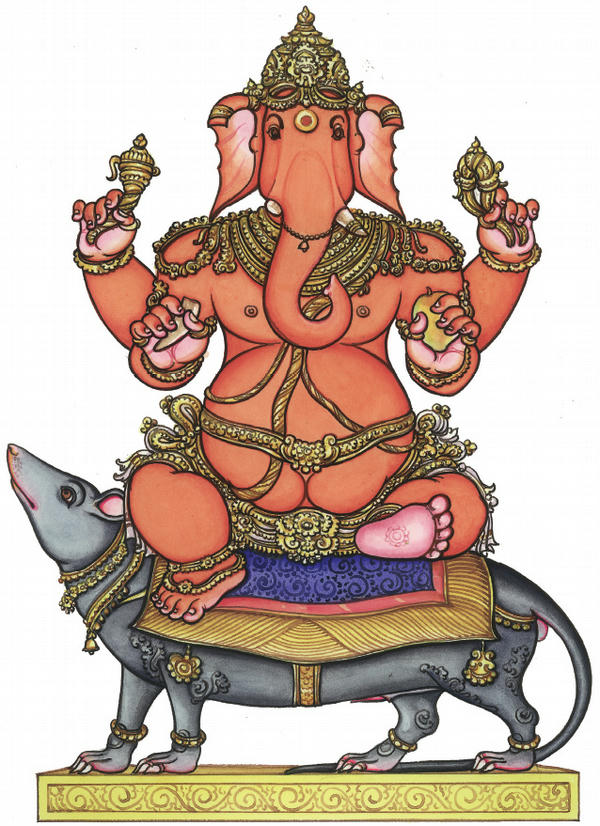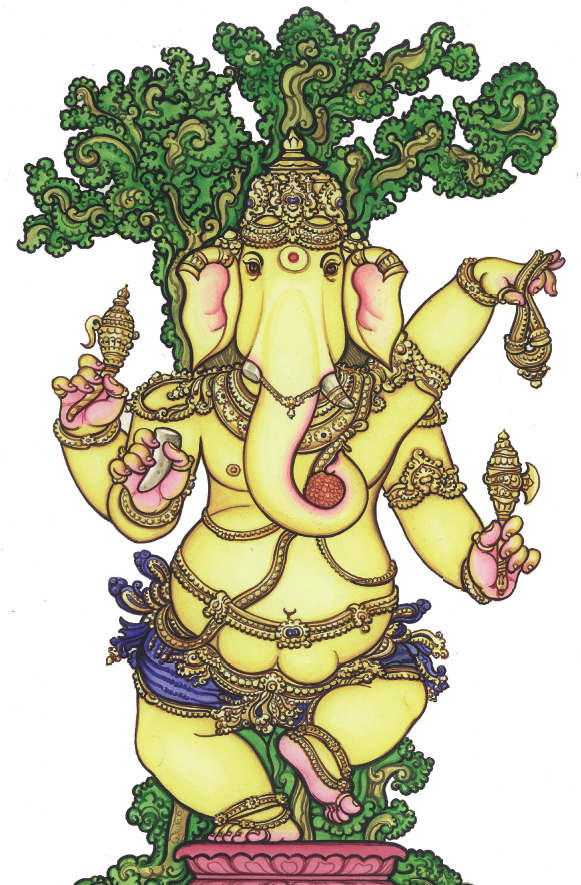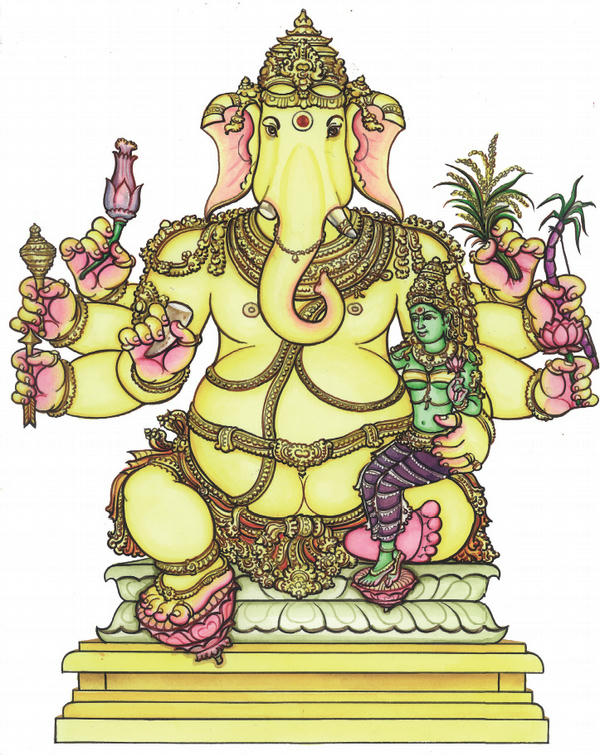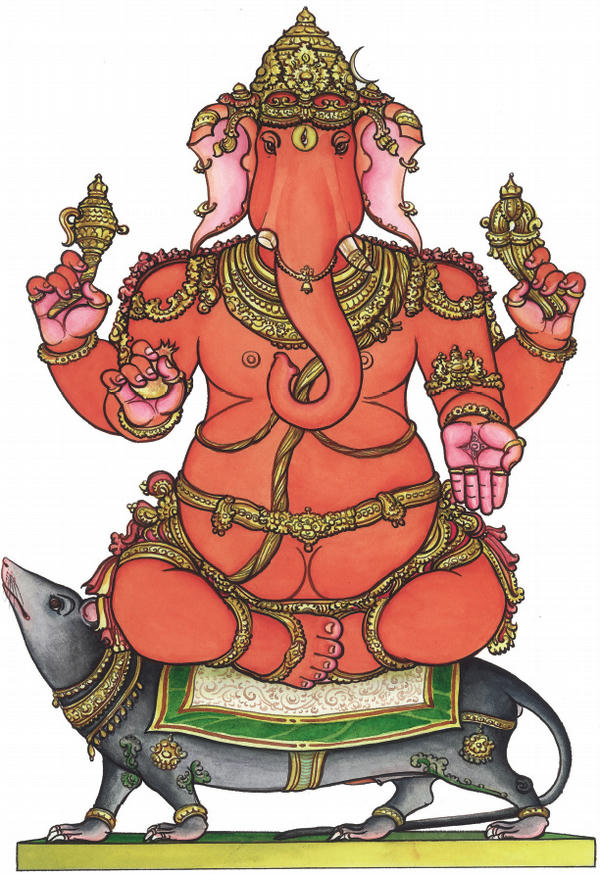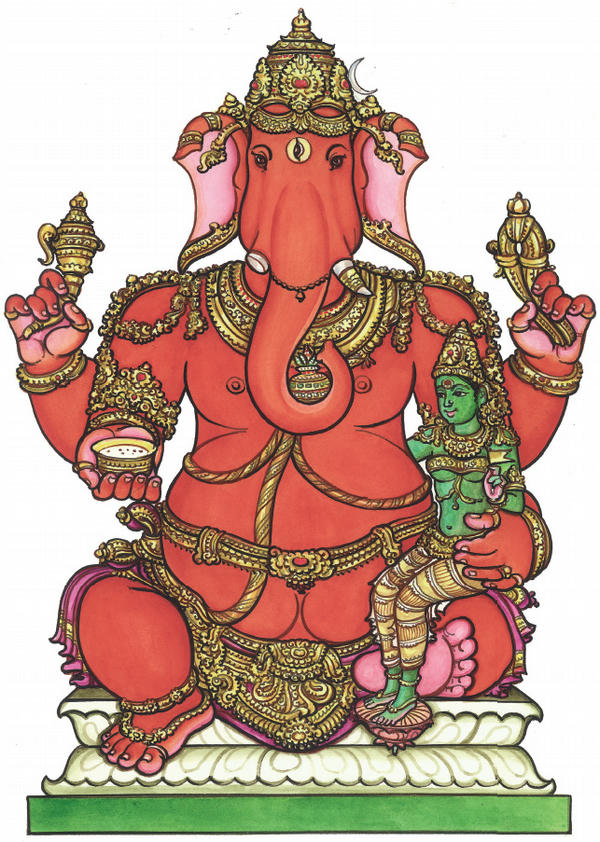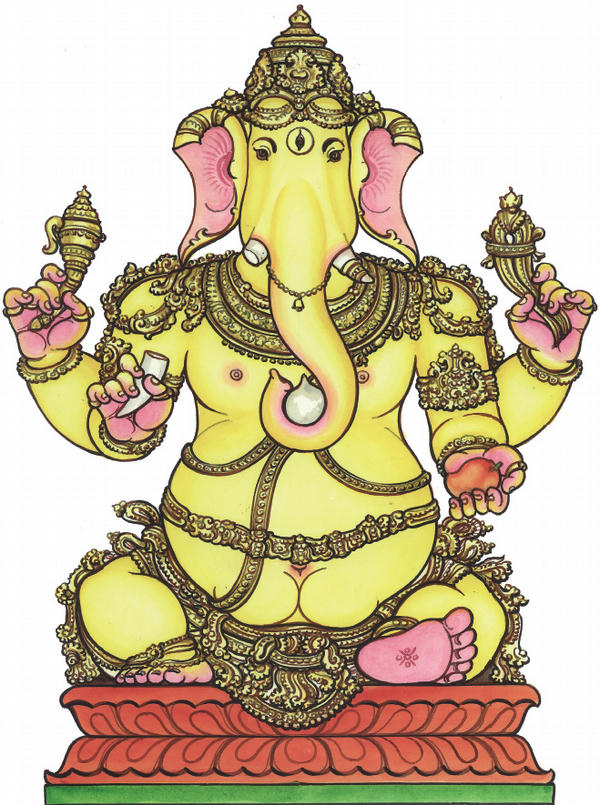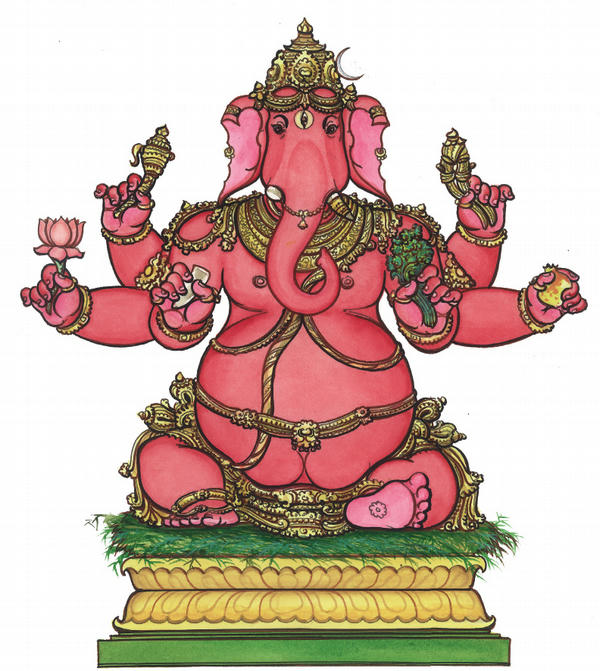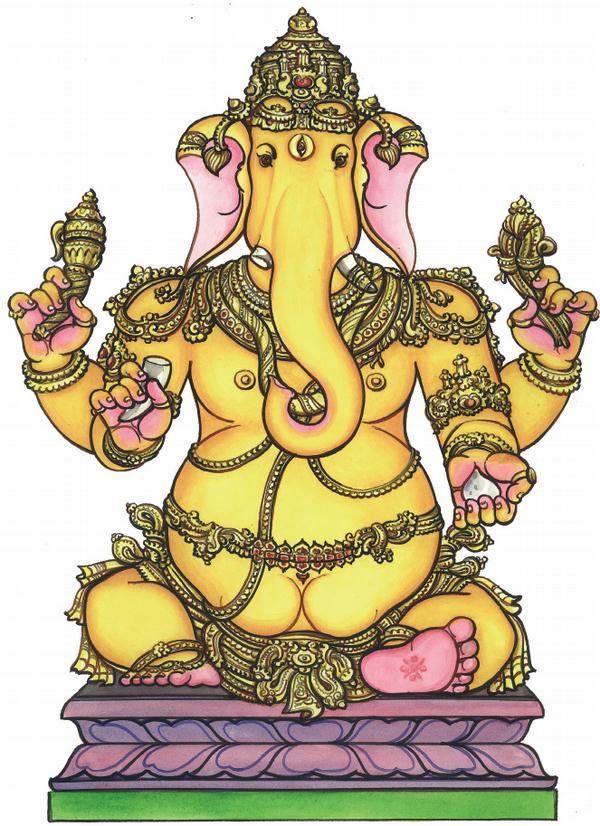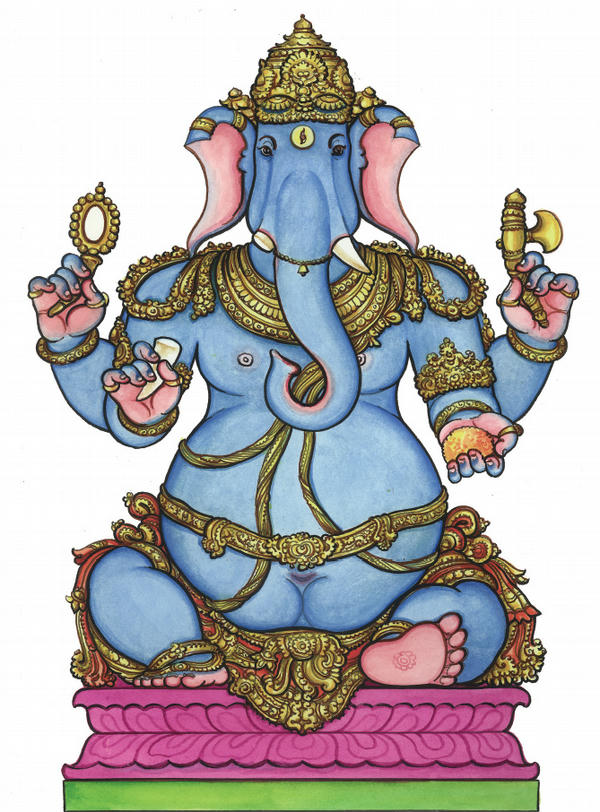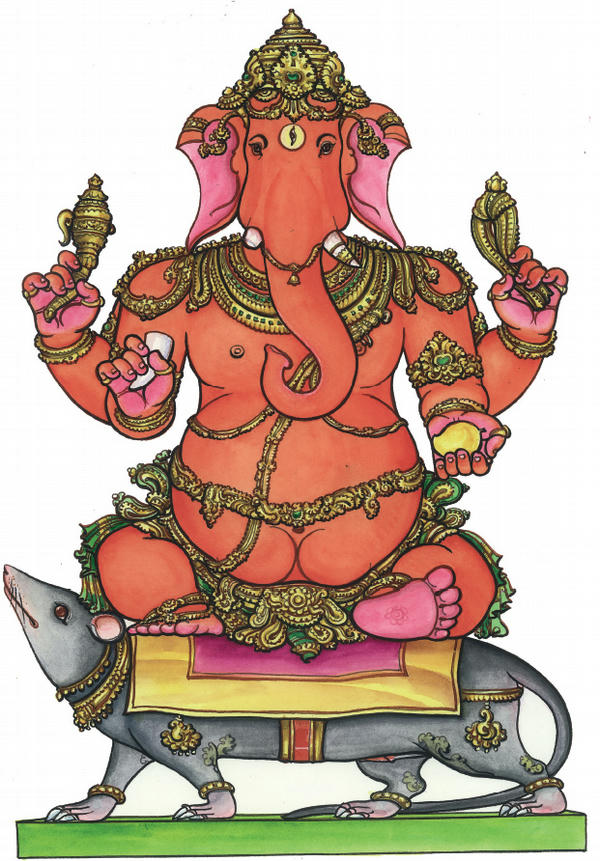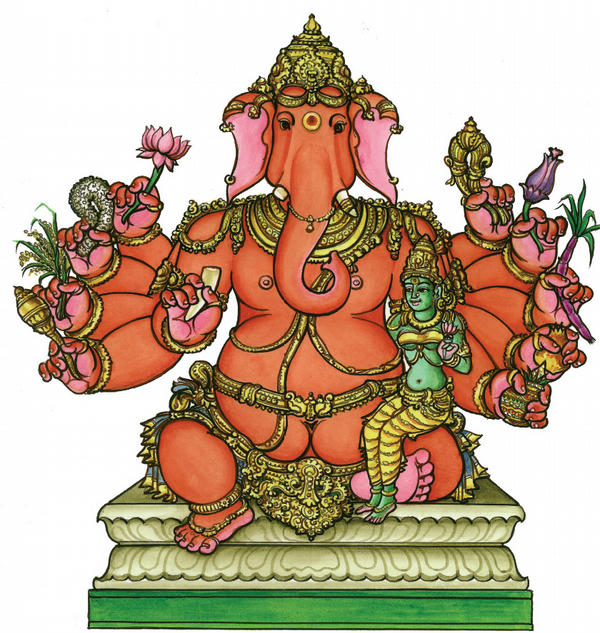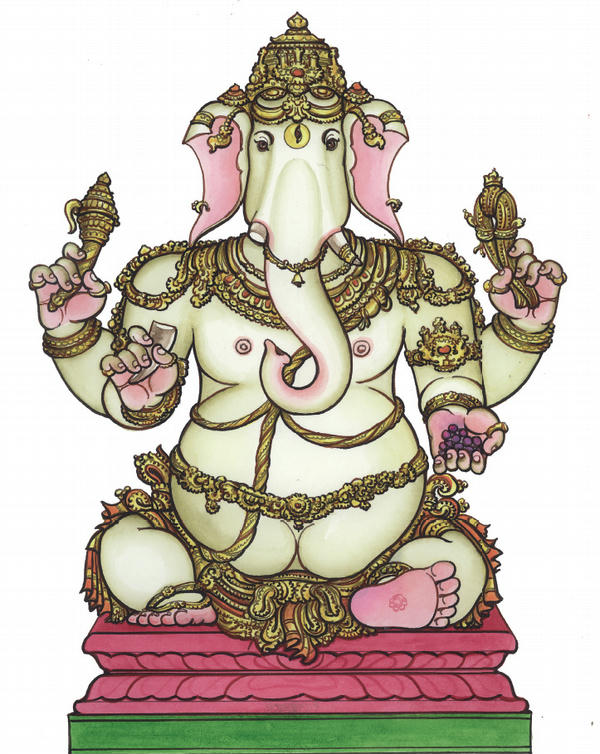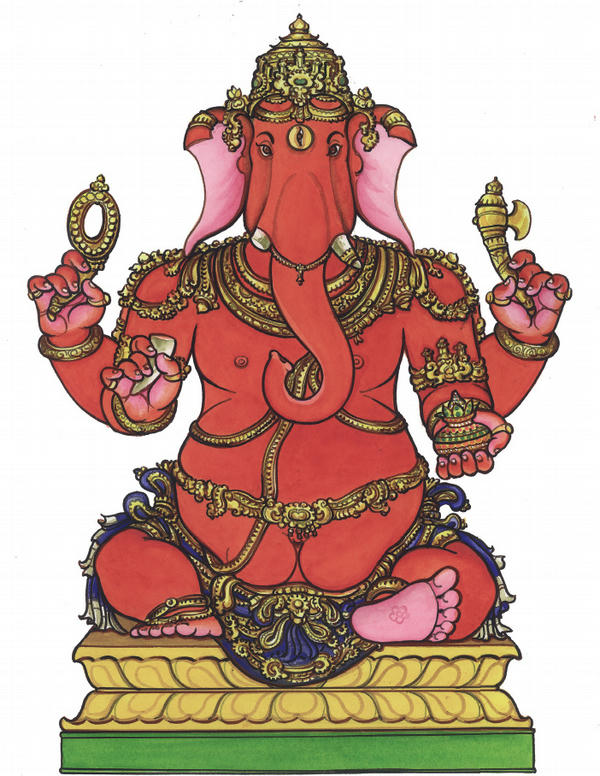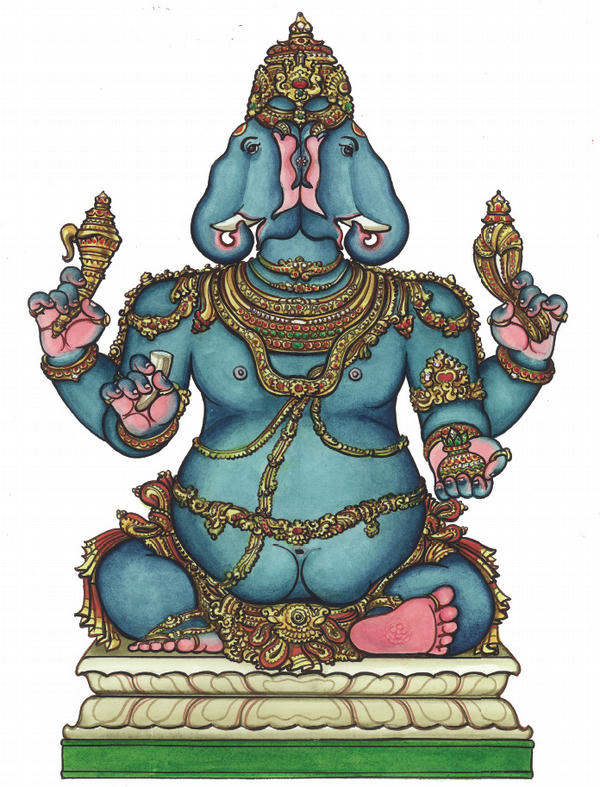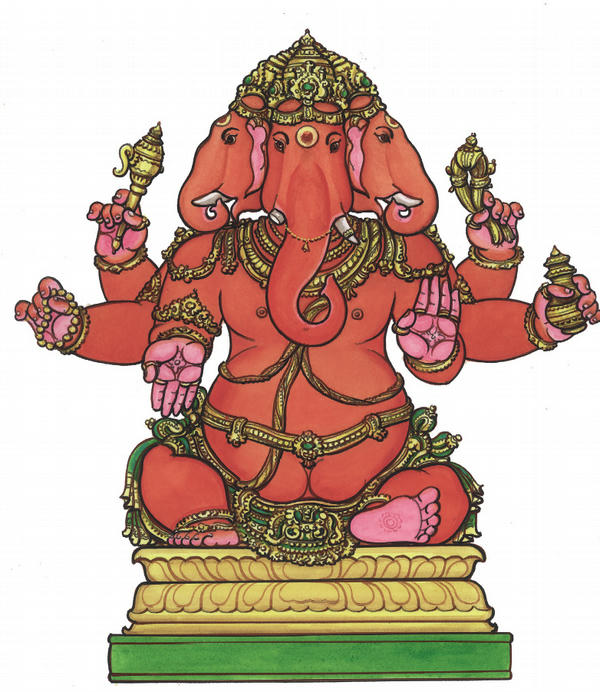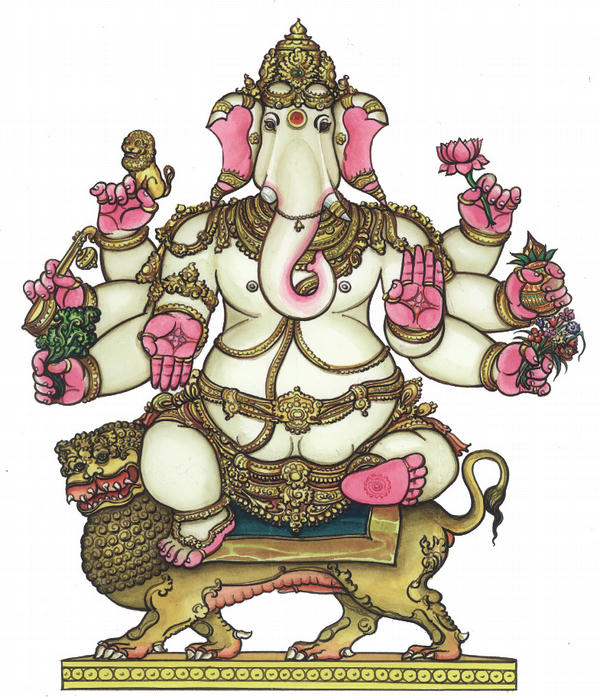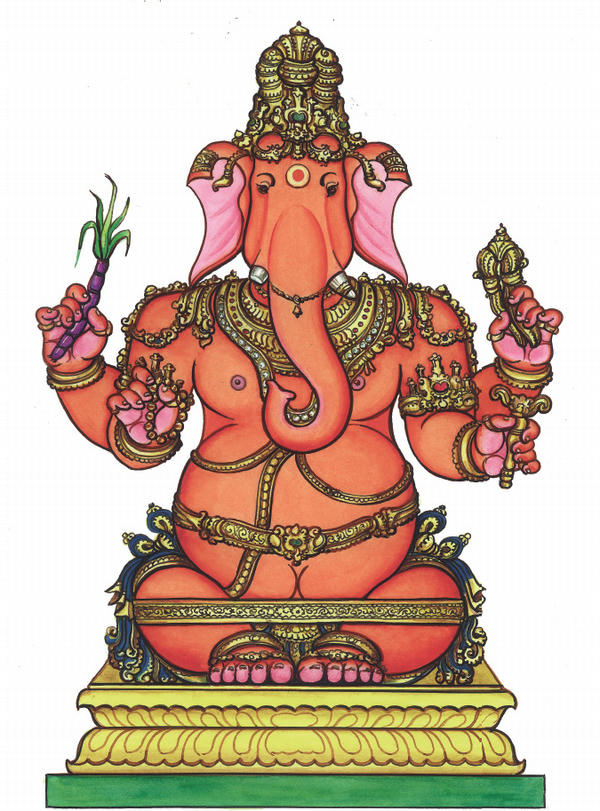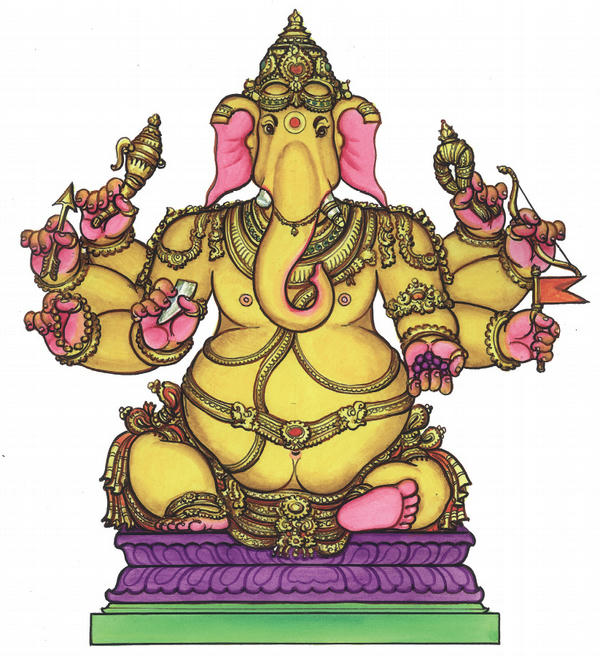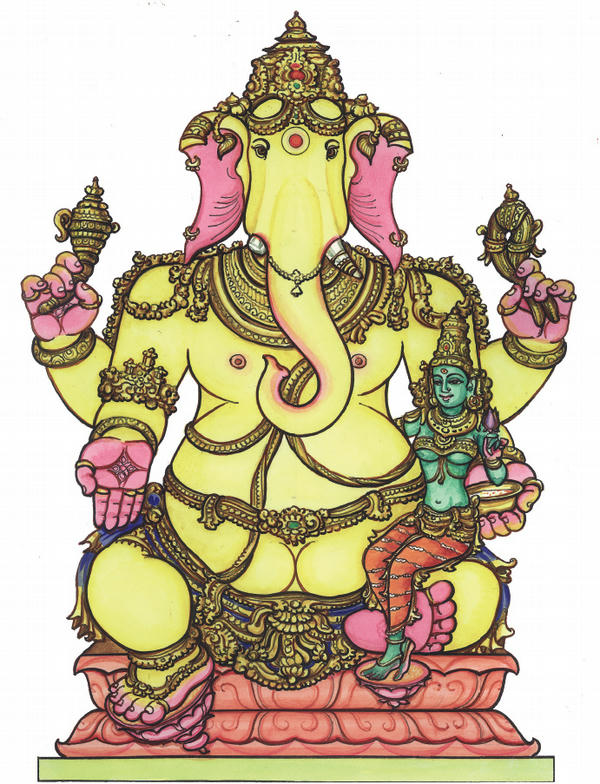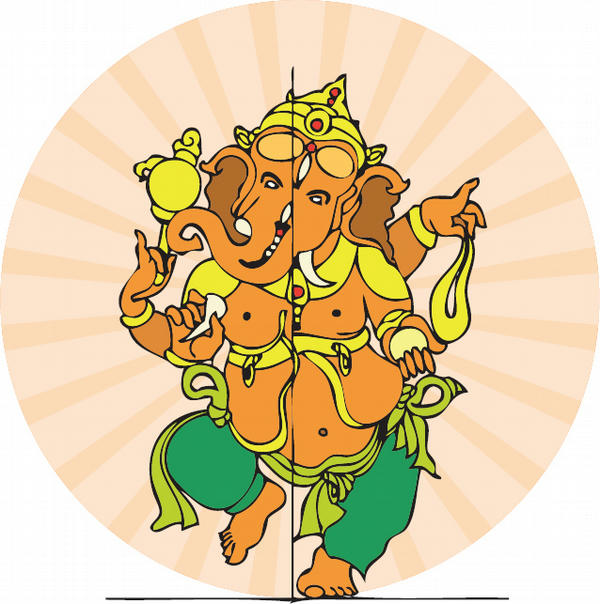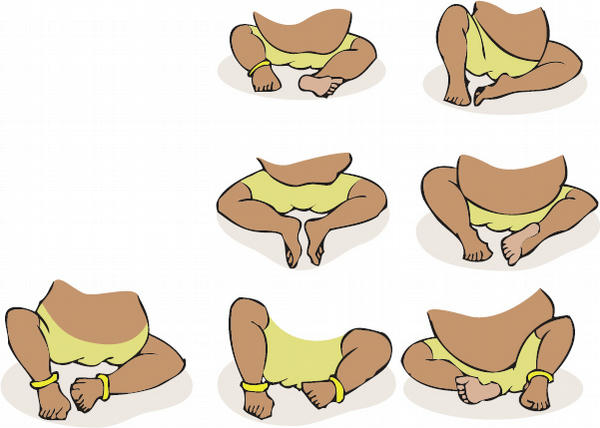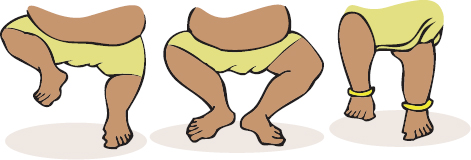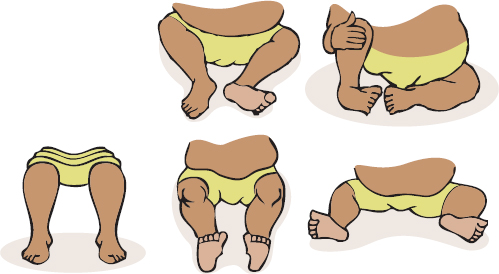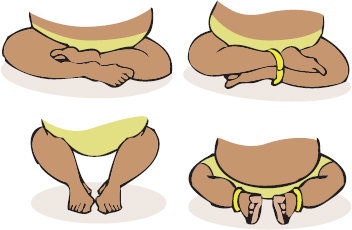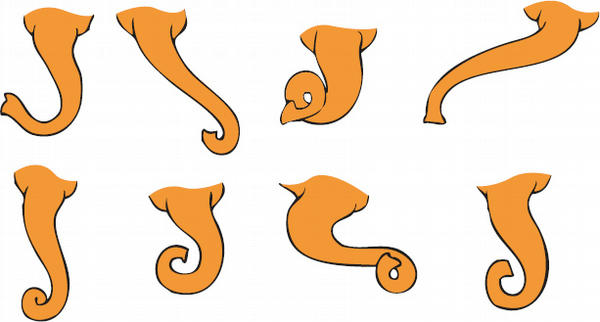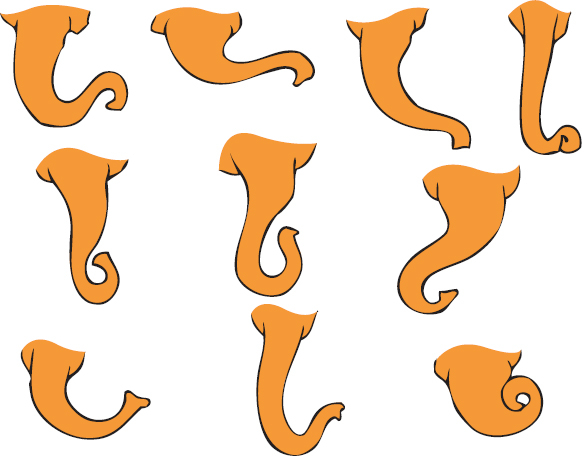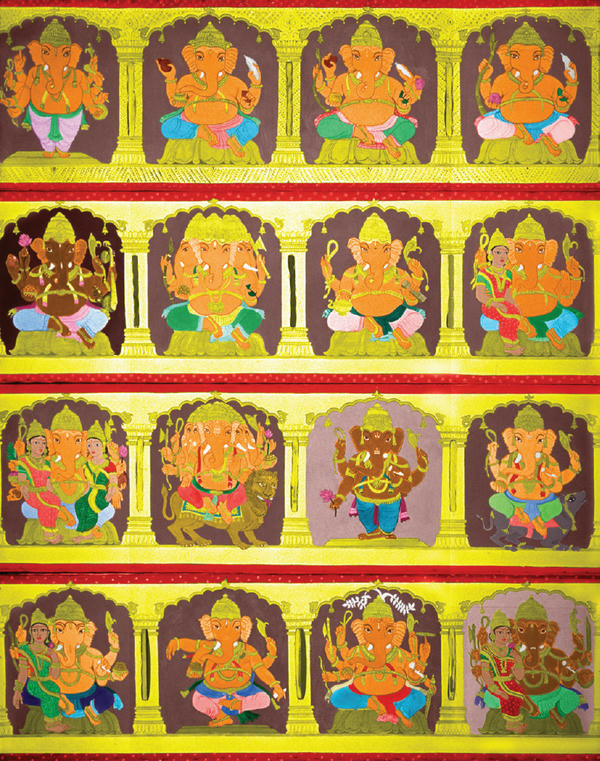Forms of Gaṇeśa§
Gaṇeśa Svarūpāṇi§
गणशस्वरूपाणि§
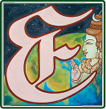 VERYWHERE IN THE MACROCOSM IS OUR BELOVED, BENEVOLENT DEITY Gaṇeśa, at every point in time, in the forces of family, community, commerce and dharma that shape our lives, as well as in our culture—indeed all cultures of the world—in the physical universe and within our hearts. Of course, He is most present in the consecrated temple or roadside shrine, from which His grace radiates out from the world of the Gods. Gaṇeśa is the Lord of beginnings, guiding the practical aspects of our lives that we may best fulfill dharma. For the Hindu, Gaṇeśa is easily contacted, and He is thought of as lenient of our errors and shortcomings, most understanding of our humanness. So vast is Gaṇeśa’s Being that He cannot be contained by any single concept, and therefore He is portrayed in many forms. He is each of them, and He is all of them.§
VERYWHERE IN THE MACROCOSM IS OUR BELOVED, BENEVOLENT DEITY Gaṇeśa, at every point in time, in the forces of family, community, commerce and dharma that shape our lives, as well as in our culture—indeed all cultures of the world—in the physical universe and within our hearts. Of course, He is most present in the consecrated temple or roadside shrine, from which His grace radiates out from the world of the Gods. Gaṇeśa is the Lord of beginnings, guiding the practical aspects of our lives that we may best fulfill dharma. For the Hindu, Gaṇeśa is easily contacted, and He is thought of as lenient of our errors and shortcomings, most understanding of our humanness. So vast is Gaṇeśa’s Being that He cannot be contained by any single concept, and therefore He is portrayed in many forms. He is each of them, and He is all of them.§
Gaṇeśa is a word compounded from the Sanskrit word gaṇa, meaning “the hosts,” “multitudes” or “troops” of demigods, especially the retinue of Lord Śiva under the rule of Gaṇeśa, and īśa, “ruler,” “lord” or “sovereign.” This is virtually synonymous with the name Gaṇapati, “master of the hosts.” As Gaṇapati, Lord Gaṇeśa is the leader of the gaṇas, ruling over the celestial hosts, over the benign as well as the malevolent inner-plane beings. He controls them not as Lord Murugan does, through bravery and forcefulness, but by strategy and intelligence. We follow the path of Lord Gaṇeśa when we resort to discrimination and sagacity to resolve our difficulties, when we proceed past obstacles in a slow, prudent and well-planned manner. Lord Gaṇeśa is not in a hurry. He is cautious. He is patient, willing to await the right time for events to take place.§
As Vighneśvara, Lord Gaṇeśa is Lord of Obstacles, creating difficulties and obstructions if the time is wrong for us to proceed and removing those same obstacles when our success is assured. It is to Vighneśvara that we supplicate before we undertake a task, plan a change in our life or begin the worship any of the other Gods.§
As Ekadanta, Lord Gaṇeśa is the Single-Tusked One, the Patron of Literature who, when all others failed, Himself undertook to scribe the great epic, Mahābhārata, dictated to Him by sage Vyāsa. He offers us here the lesson in life that knowledge and dharma are of utmost importance, worth sacrificing even pride and beauty to attain.§
As Siddhidātā, Lord Gaṇeśa is the Giver of Success associated with bountiful harvests and general abundance in life. It is said that Lord Gaṇeśa is the material manifestation of the manas, or mind, of Lord Śiva, and that He embodies the five elements—earth, air, fire, water and ether—and guides the elemental forces that produce and maintain order in the universe.§
The Mudgala Purāṇa, an ancient text on Lord Gaṇeśa, cites eight forms of Gaṇeśa, prevailing over eight human weaknesses or demons. Ekadanta is the Conquerer of Moda, arrogance. Dhumravarṇa (smoke colored) overcomes Abhimāna, pride; Vakratuṇḍa (curved trunk) is the Vanquisher of Matsarya, jealousy; Mahodara (big belly) is Lord of Moha, infatuation; Gajānana (elephant face) conquers Lobha, greed; Lambodara (corpulent belly) overcomes Krodha, anger; Vikaṭa (huge) conquers Kāma, lust; Vighnarāja (King of Obstacles) prevails over Mamatā (egotism).§
So now we can see that our loving Gaṇeśa is “there” for even the lowest of the low, that there is hope for everyone, and that there really is “no intrinsic evil,” only a seeming variation of the past containing all that has to be learned to live and grow from a young soul to an older one and then mature into ṛishi consciousness. He is “there for us.” Yes, there is hope for all, and none is damned forever. It is our loving Gaṇeśa who eventually introduces us to His brother, our loving Murugan, the God Who sits upon the maṇipūra chakra, center of willpower.§
The Two Śaktis of Lord Gaṇeśa§
There is a confusion regarding the two consorts of Lord Gaṇeśa: Buddhi and Siddhi, with whom He is often represented. Buddhi is wisdom, or more precisely sagacity, the intelligent and discriminating use of knowledge. Siddhi is success, or more precisely fulfillment, accomplishment or attainment. While in North India Gaṇeśa is conceived as having two consorts, in the South He is looked upon as a brahmachārī, or bachelor. Esoterically, it must be stressed that none of the Gods has a wife. Their consorts are not to be considered as separate from them, but as aspects of their being, as their śakti, or power. The Mahādevas, who live in the inner Third World, cannot be likened to men and women who live on the Earth, known as the First World. They exist in perfectly evolved soul bodies, bodies which are not properly differentiated by sex. They are divine beings made of pure consciousness and light; they are neither male nor female. To better understand these divine Gods, we sometimes conceive of them as being the man if they are strong in expression or the woman if they are gentle and compassionate. In truth, this is a misconception. There are no husbands and wives in the vast superconscious realms of the Third World, or Śivaloka. Thus, Buddhi and Siddhi are properly seen as the two śaktis—wisdom and success—of the great Gaṇeśa, and not as His so-called consorts. These two represent benefits or boons accrued by His worshipers. In an inner sense, Buddhi and Siddhi are the iḍā and piṅgalā nāḍīs, the female and male currents, both of which are embodied within the being of Gaṇeśa, corresponding to Vallī and Devayāni, the mythological consorts of Lord Murugan.§
The Quiet Within§
Our Loving Ganesha’s a powerful God
Yet, He is so quiet you might think it odd
That such a meticulous, intricate soul
Would care to guide all of our karma so old.§
Indeed it is fortunate that He is so near
For if He were not we would hardly be here,
For He holds the base chakra so firmly in place
That we may thus live in this one time in space.§
Pray to Him dearly, and truth you’ll be seeing
That the quiet inside is the cave of your Being,
To attain through your striving, to be quiet within,
That the heritage of all happy births you will win.§
Thirty-Two Forms of Gaṇeśa§
In temples and shrines around the planet, from Moscow to London, from Durban to Kuala Lumpur, Gaṇeśa’s worshipful image, or mūrti, appears in many forms. The Mudgala Purāṇa, in addition to the above eight, lists thirty-two. We present sketches here of these on the following pages. It may interest you to know that the first sixteen mūrtis, the Shoḍaśa Gaṇapati, are installed in an eight-sided, chariot-shaped structure at the Śrī Śaṅkara Maṇḍapam of Rāmeśvaram, South India, established by the late Śrī lā Śrī Chandraśekharendra Saraswati, 68th preceptor of the Kanchi Kāmakoti Pīṭham.§
1§
Bāla Gaṇapati§
बालगणपति§
Bāla Gaṇapati is “the Childlike” God of golden hue. In His hands He holds a banana, mango, sugarcane and jackfruit, all representing the Earth’s abundance and fertility. His trunk garners His favorite sweet, the modaka.§
2§
Taruṇa Gaṇapati§
तरुणगणपति§
Eight-armed Taruṇa Gaṇapati, “the Youthful,” holds a noose and goad, modaka, wood apple, rose apple, His broken tusk, a sprig of paddy and a sugarcane stalk. His brilliant red color reflects the blossoming of youth.§
3§
Bhakti Gaṇapati§
भक्ति गणपति§
Shining like the full moon during harvest season and garlanded with flowers, Bhakti Gaṇapati, dear to devotees, is indeed pleasant to look upon. He holds a banana, a mango, coconut and a bowl of sweet pāyasa pudding.§
4§
Vīra Gaṇapati§
वीर गणपति§
The “Valiant Warrior,” Vīra Gaṇapati, assumes a commanding pose. His sixteen arms bristle with weapons, symbols of mind powers: a goad, discus, bow, arrow, sword, shield, spear, mace, a battleaxe, a trident and more.§
5§
Śakti Gaṇapati§
शक्तिगणपति§
Four-armed and seated with one of His śaktis on His knee, Śakti Gaṇapati, “the Powerful,” of orange-red hue, guards the householder. He holds a goad and a garland noose, while bestowing blessings with the abhaya mudrā.§
6§
Dvija Gaṇapati§
द्विजगणपति§
Four-headed Dvija Gaṇapati, “the Twice-Born,” is moon-like in color. Holding a noose, a goad, an ola leaf scripture, a staff, water vessel and a His japa beads, He reminds one and all of the urgency for disciplined striving.§
7§
Siddhi Gaṇapati§
सिद्धिगणपति§
Golden-yellow Siddhi Gaṇapati, “the Accomplished,” is the epitome of achievement and self-mastery. He sits comfortably holding a bouquet of flowers, an axe, mango, sugarcane and, in His trunk, a tasty sesame sweet.§
8§
Ucçhishṭa Gaṇapati§
उच्छिष्टगणपति§
Ucçhishṭa Gaṇapati is “Lord of Blessed Offerings” and guardian of culture. Of blue complexion and six-armed, He sits with His Śakti, holding a vīṇā, pomegranate, blue lotus flower, japa mālā and a sprig of fresh paddy.§
9§
Vighna Gaṇapati§
विघ्नगणपति§
Vighna Gaṇapati, “Lord of Obstacles,” is of brilliant golden hue and bedecked in jewels. His eight arms hold a noose and goad, tusk and modaka, conch and discus, a bouquet of flowers, sugarcane, flower arrow and an axe.§
10§
Kshipra Gaṇapati§
क्षिप्रगणपति§
Handsome, red-hued Kshipra Gaṇapati, “Quick-acting” giver of boons, displays His broken tusk, a noose, goad and a sprig of the kalpavṛiksha (wish-fulfilling) tree. In His uplifted trunk He holds a tiny pot of precious jewels.§
11§
Heramba Gaṇapati§
हेरम्बगणपति§
Five-faced, white in color, Heramba Gaṇapati, “Protector of the Weak,” rides a fearsome lion. He extends the gestures of protection and blessing while holding a noose, japa beads, axe, hammer, tusk, garland, fruit and modaka.§
12§
Lakshmī Gaṇapati§
लक्ष्मीगणपति§
Lakshmī Gaṇapati, pure white giver of success, sits flanked by Wisdom and Achievement. Gesturing varada mudrā, He holds a green parrot, a pomegranate, sword, goad, noose, sprig of kalpavṛiksha and a water vessel.§
13§
Mahā Gaṇapati§
महागणपति§
Accompanied by one of His śaktis, “the Great,” Mahā Gaṇapati, is red-complexioned and three-eyed. He holds His tusk, a pomegranate, blue lily, sugar-cane bow, discus, noose, lotus, paddy sprig, mace and a pot of gems.§
14§
Vijaya Gaṇapati§
विजयगणपति§
Four-armed, of red hue and riding His resourceful mūshika, Vijaya Gaṇapati is “the Victorious” bestower of success. His insignia are the broken tusk, elephant goad, a noose and a lucious golden mango, His favorite fruit.§
15§
Nṛitya Gaṇapati§
नृत्यगणपति§
The happy “Dancer,” Nṛitya Gaṇapati, is four-armed and golden, with rings on His fingers, holding a tusk, goad, noose, axe and modaka sweet. He prances under the kalpavṛiksha tree, epitomizing exuberant activity and joy.§
16§
Ūrdhva Gaṇapati§
ऊर्ध्वगणपति§
Seated with one of His śaktis on His left knee, Ūrdhva Gaṇapati is “the Elevated” Lord of golden hue. In His six hands He holds a sprig of paddy, a lotus, the sugarcane bow, an arrow, His ivory tusk and a blue water lily.§
17§
Ekākshara Gaṇapati§
एकाक्षरगणपति§
Ekākshara, of “Single-Syllable” (gaṁ), is three-eyed, of red complexion and attire. Crescent moon on His crown, He sits in lotus pose upon Mūshika, offers the boon-giving gesture and holds a pomegranate, noose and goad.§
18§
Varada Gaṇapati§
वरदगणपति§
Varada Gaṇapati, “the Boon-Giver” with prominent third eye of wisdom, holds a dish of honey, the noose and goad and encloses a pot of jewels in His trunk. His śakti is at His side, and the crescent moon adorns His crown.§
19§
Tryakshara Gaṇapati§
त्र्यक्षरगणपति§
Tryakshara Gaṇapati, “the Lord of Three Letters” (A-U-M), is gold in color and has fly whisks in His big floppy ears. He carries the broken tusk, goad, noose and mango and is often seen grasping a sweet modaka in His trunk.§
20§
Kshipra-Prasāda Gaṇapati§
क्षिप्-प्रसादगणपति§
Kshipra Prasāda Gaṇapati, “the Quick Rewarder,” presides from a kusha-grass throne. His big belly symbolizes the manifest universe. He holds a noose, goad, tusk, lotus, pomegranate and a twig of the wish-fulfilling tree.§
21§
Haridrā Gaṇapati§
हरिद्रागणपति§
Haridrā Gaṇapati, “Turmeric Colored,” dressed in bright yellow vestments, sits calmly on a posh, regal throne. Along with His tusk and a modaka, He wields a noose to hold devotees close and a sharp goad to spur them onward.§
22§
Ekadanta Gaṇapati§
एकदन्तगणपति§
Ekadanta, of “Single Tusk,” is distinguished by His blue color and sizeable belly. The attributes of this mūrti are an axe for cutting the bonds of ignorance, prayer beads for japa, a laḍḍu sweet and the broken right tusk.§
23§
Sṛishṭi Gaṇapati§
सृष्टिगणपति§
Riding on His docile and friendly mouse, Sṛishṭi Gaṇapati is the lord of happy “Manifestation.” This active God, of red complexion, holds His noose a goad, a perfect mango and His tusk, representing selfless sacrifice.§
24§
Uddaṇḍa Gaṇapati§
उद्दण्डगणपति§
Uddaṇḍa Ganapati is the bold “Enforcer” of Dharma, the laws of being. His ten hands hold a pot of gems, a blue lily, sugarcane, a mace, lotus flower, sprig of paddy, a pomegranate, noose, garland and His broken tusk.§
25§
Ṛiṇamochana Gaṇapati§
ऋणमोचनगणपति§
Ṛiṇamochana Gaṇapati is humanity’s liberator from guilt and bondage. His figure of alabaster skin is apparelled in red silks. He bears a noose and a goad, His milk-white tusk and a favorite fruit, the rose apple.§
26§
Ḍhuṇḍhi Gaṇapati§
ढुण्ढिगणपति§
Red-hued Ḍhuṇḍhi Gaṇapati, “the Sought After,” holds a strand of rudrāksha beads, His broken tusk, an axe and a small pot of precious gems thought to represent the treasury of awakenings He saves for all ardent devotees.§
27§
Dvimukha Gaṇapati§
द्विमुखगणपति§
Dvimukha Gaṇapati, called Janus by the Romans, with two divergent faces, sees in all directions. His blue-green form is dressed in red silk. He wears a bejeweled crown and holds a noose, goad, His tusk and a pot of gems.§
28§
Trimukha Gaṇapati§
त्रिमुखगणपति§
Trimukha Gaṇapati, the contemplative “three-faced” Lord of red hue, sits on a golden lotus, telling His beads, holding a noose, goad and vessel of nectar. He gestures protection with a right hand and blessings with a left.§
29§
Siṅha Gaṇapati§
सिन्हंगणपति§
Siṅha Gaṇapati, white in color, rides a lion and displays another lion in one hand, symbolizing strength and fearlessness. He also holds a kalpavṛiksha sprig, the vīṇā, a lotus blossom, flower bouquet and a pot of jewels.§
30§
Yoga Gaṇapati§
योगगणपति§
Yoga Gaṇapati is absorbed in mantra japa, His knees strapped in meditative pose, hands holding a yoga staff, sugarcane stalk, a noose and prayer beads. His color is like the morning sun. Blue garments adorn His form.§
31§
Durga Gaṇapati§
दुर्गगणपति§
Durga Gaṇapati, the “Invincible,” waves the flag of victory over darkness. This splendid mūrti is of deep gold hue, dressed in red, holding a bow and arrow, noose and goad, prayer beads, broken tusk and a rose apple.§
32§
Saṅkaṭahara Gaṇapati§
संकटहरगणपति§
Saṅkaṭahara Gaṇapati, “the Dispeller of Sorrow,” is of sunlike hue, dressed in blue, and seated on a red lotus flower. He holds a bowl of pudding, a goad and a noose while gesturing the boon-granting varada mudrā.§
Gaṇeśa Iconography§
By Dr. L.S. Madhava Rao,
From “Gaṇeśa as Primus Inter Pares,”
Published in the Organiser, September 18, 1994§
In every Hindu function, invocation to Lord Gaṇeśa for His blessings takes precedence over all other Gods to ward off any mishap. This has been the practice from the Vedic times. Every part of Gaṇeśa’s body, such as ear, nose, eyes, trunk, has some significance. One has only to know it, believe in it and follow it. He is intellect par excellence. A critical examination of the various names of the Deities will enable us to know and trace the features of religious development and understand the religious tendencies of the people. Here an attempt is made to highlight how Lord Gaṇeśa in His different bhaṅgimas (postures and attitudes) is worshiped in Āgamic temples.§
1. Icons without headdress in the sitting pose and with two arms: To this class belong two variations. The first is the prevalent utkuṭakāsana [“sitting on the hams” with one or both knees raised] see illustration, page 120). Second is Gaṇeśa seated in padmāsana, lotus pose, with legs crossed, which is quite rare.§
2. Gaṇeśa icons with two arms and headdress: These images are mostly carved out of stone and normally belong to a period between the 9th and 12th centuries. These are represented in the usual utkuṭaka pose, and the proboscis is shown taking a left turn and eating from a bowl of pudding held in the left hand.§
3. Four-armed figures without alaṅkāra [ornamentation] and prabhāvalī [encircling arch]: These are discernable specimens of early Gaṇapati sculpture with four arms, devoid of any kind of ornamentation and with little proportion.§
4. Gaṇapati icons with four arms, ribbon-like prabhāvalī, jaṭāmukuṭa [crown of matted hair] and udarabandha [waist band]: These figures are usually ascribed to the period between the 9th and 12th centuries. They are mostly carved out of hard granite, and they present a pleasant and elegant form.§
5. Gaṇapati icons with four arms and with bowl-like kinita or with conical or karaṇḍa mukuṭa [basket-shaped crown]. This type of Gaṇapati image is datable to the 10th, 11th or 12th centuries. They may not have the mount or profusion of alaṅkara. The prabhāvalī resembles a semicircular tape or is flame-like.§
6. Gaṇapati icons representing the Hoysala type: These figures are known for their profusion in ornamentation, delicacy of taste and elegance.§
7. Gaṇapati icons with the usual nāgabandha, vāhana, karaṇḍa mukuṭa and conventionalized form of details: These figures are assigned to the period between the 14th and 18th centuries. They represent the various forms of Gaṇapati according to the textual prescription.§
8. Gaṇapati icons in tribhaṅga: Hitherto, four bronzes have been discovered in the tribhaṅga pose. Three are ascribed to the 10th century. [Below is an example of tribhaṅga in nṛitya (dancing) pose, from a sthapati’s sketch on a workshop wall in Mahabalipuram, Tamil Nadu.]§
9. Nṛitya Gaṇeśa, the dancing form: Only two [ancient] icons of this type have come to light so far. One is a small (20cm high) stone icon at Hariharakshetra, Subrahmanya. The other is a bronze in the Raghavendra Maṭha in Udīpi. This bronze is of considerable iconographic interest. In features, although it presents conventional forms, its theological background is rather unique.§
Gaṇeśa’s Seating and Standing Poses§
Gaṇeśa’s Trunk Poses§
On the following page are numerous trunk poses. The first group are examples of valampuri (turning to the right). Group two are edampuri (turning left). In most icons of Loving Ganeśa the trunk is turned toward the left (from the perspective of the Deity). Only in rare cases is it turned to the right.§
Valampuri Pose§
Trunk turning to the Deity’s right. This form is very rare.§
Edampuri Pose§
Trunk turning to the Deity’s left. This is the common form.§
